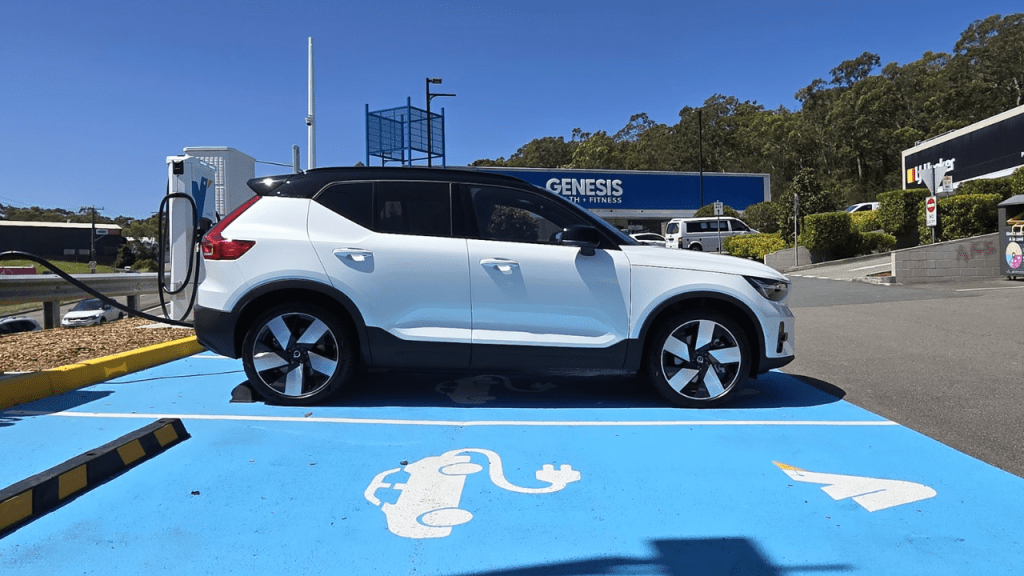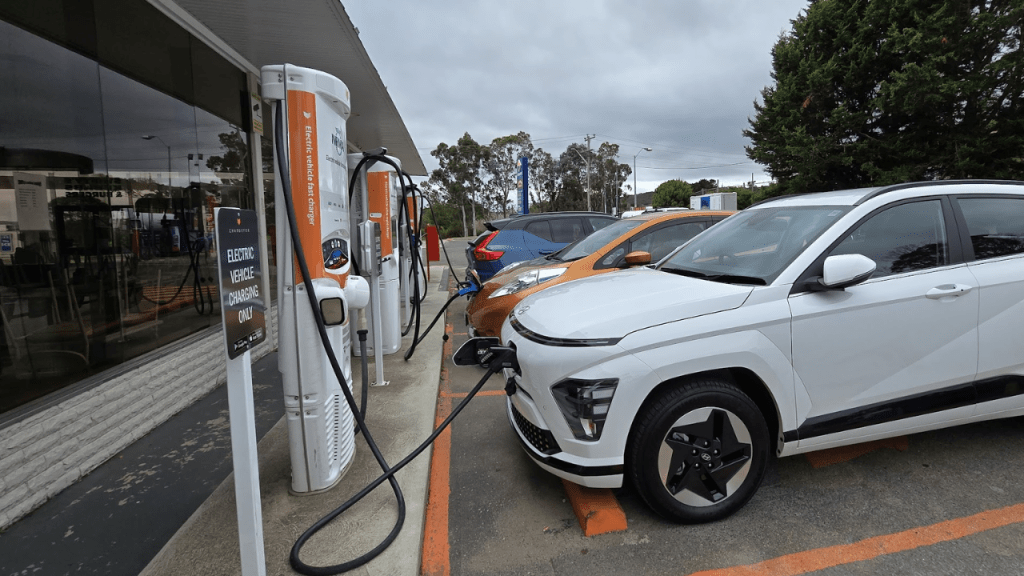The ball is well and truly rolling on EVs. Uptake in Australia is rising, more companies are bringing their models down under, and year on year, models of all types are becoming cheaper.
However, problems with public charging are still plaguing the burgeoning automotive tech and its severely kneecapping user experiences.
If you own an EV in Australia, then you may know about Plugshare, the app is community-run by EV owners and is designed to let drivers know where they can get a charge reliably or what chargers are out of service.
The most useful thing about Plugshare is its user reviews section, where when you tap on a specific charger, you can see what users have had to say about it. Often with public chargers, particularly those capable of whopping-fast capacities of 350kW DC, and even down to still relatively fast speeds of 50kW, you’ll come across users complaining about downtime: the chargers being broken.
That is the core of the problem. I made a point of it in my article on what I’ve learned since I started becoming an EV reviewer. Public charging is riddled with problems that make it seem abysmal at the best of times. I likened it to reeking of “startup energy”.
We can summarise the problems with public charging down to three factors, interoperability, reliability and investment priorities.

Problem One: Interoperability
It’s easy for us to define interoperability as one of the major problems with public charging. As far as a driver is concerned, interoperability refers to the apps used to connect with a charging station and to initiate a charge. It couldrefer to plugs too, but most EVs in Australia use the same ports (not the Nissan Leaf though, which is at a major public charging disadvantage).
But when we have so many different companies rolling out chargers, interoperability becomes a problem because you need separate apps for Evie, Chargefox, NRMA, BP Pulse, Ampol, and other chargers. Each of these apps would then require billing information set up, and most require having an account. It’s a nightmare for user-friendliness.
St Baker Fellow in E-Mobility at the University of Queensland’s School of Chemical Engineering, and Faculty of Engineering, Architecture and Information Technology, Dr Kai Li Lim spoke to Gizmodo Australia saying there is a simple way to fix this issue.
“The most elegant way to do this, and Evie networks has done this, is to simply put a card reader on your charging station – and then you don’t have to download any apps,” Doctor Lim said.
The problem here though is, well, most chargers don’t do it this way. Even Evie is only trialling debit card reading at select charging stations.
The alternative is what every other charging network has in place, handling it through an app. It might seem like a non-issue, with the ability to start a charge from a map of activatable chargers. But take it from me, it offloads significant points of failure to the end user. For example, if their phone battery is dead, they don’t have any reception, or the app is playing up.
All three of these things have happened to me during my time reviewing electric cars. A dead phone battery is easy, if slow, to resolve, but the other two, not so much. Using a phone app at Sutton’s Forest Evie chargers, a major charging stop on the corridor between Canberra and Sydney, had huge network coverage issues that saw me walking quite far before I could start a charge from my phone (I was accessing the Telstra network via Belong).
Meanwhile, NRMA’s EV charging app, which doubles as the company’s ‘My NRMA’ service app, has an exceptionally poor user experience, and at one point with the company’s Olympic Park chargers, I was unable to begin a session simply because assets on the app were failing to load.
“In an ideal world, you only need one app to control, to charge at any of the charging stations,” Doctor Lim added, noting station operators could form an ‘alliance’ with a third-party app provider to offer just one app, but at the end of the day, he said somebody has to make a profit.
Lim said eventually, charging stations might start to introduce machines similar to parking ticket machines for payments, in lieu of the traditional cashier model at petrol stations.
“We’ve seen that overseas”, he said.
We’re not forgetting about Tesla with this discussion. Tesla’s charging stations operate very differently. With card details saved to the car itself, a Tesla driver can rock up to a Tesla supercharger, plug the car in, and it will immediately start charging. It’s a user experience that Tesla can pull off by having complete control over both charger and car, though we may see it jump to other brands. Ford, for example, offers the system for Mustang Mach-E’s in the U.S., with participating Tesla and Electrify America stations.
“The international standard is there, it has been finalised… You just need people to implement it,” Lim added.

Problem Two: Reliability
EV charging companies often make bold claims about uptime across their whole networks. In May, Evie claimed a 97 per cent uptime across its network of chargers, which includes some of the fastest chargers available in Australia, at up to 350kW DC capacities. It’s an interesting claim to interrogate.
“Guaranteeing the uptime is one thing, right?” Doctor Lim said. “All charging stations would have uptime, so it sends a signal to a server, and it says it’s online, and reports that it’s online – but that’s if the station is up, and if something is powering the station. Effectively, it’s online.”
“And that’s why a lot of these charging station operators are claiming that they have more than a per cent.”
New legislation tabled late last year included sturdy requirements for government-funded public chargers, including a requirement that such chargers would need to be operational for 98 per cent of the time.
However, such uptime requirements are naturally difficult to comply with. Vandalism, debris in the chargers, and accessibility to the charging sites, along with problems affecting chargers that might not be reportable by the system (such as screen faults) are harder to be across for charging companies than a simple ‘charger is online’ signal.
“There needs to be a more holistic way of ensuring that the uptime of chargers takes into consideration the accessibility of chargers, because if a charger is inaccessible, it doesn’t really matter if it’s up or not,” Lim added.
Asking why many public chargers aren’t sheltered from the elements, Lim said its all about the money. Plus, the installation of a roof could cause headaches for potential expansion later on.
“The investment is placed for charging stations, and not for the site,” Doctor Lim said.

Problem Three: Investment priorities
EV technology is evolving rapidly, and though it’s better now than it was four years ago, it’ll likely be even better five years from now, with faster chargers and larger batteries constantly being rolled out. More appealing tech means greater interest from prospective buyers – be it casual consumers or network operators themselves, which puts immense pressure on the decisions for charger installations and upgrades across the country.
If you were to look at Plugshare, and filter it to only include chargers surpassing a 200kW DC capacity, then you’d notice the bulk of them are located across the East Coast.
Filtering it down to include chargers surpassing 150kW, and then 50kW, paints a much better picture across the country, however, the Eastern city artery roads remain the focus, understandably so, considering that’s where most of the country lives.
But even with this focus, Lim said EV networks need to keep their investment priorities close to heart.
“Just putting a lot of money into the investments, but not having real foresight about what’s going to happen to these chargers makes it seem like a very shortsighted approach,” he said. “It’s easy to make the targets… but what happens in the future is somebody else’s problem.”
Lim added this problem is exacerbated by the fact there are so many small to medium-sized businesses, each operating with a higher risk in the market, handling the essential infrastructure for a burgeoning transport segment.
This is not unlike what happened to Tritium – the Australian unicorn that once made headlines as an Australian EV success story with its widely popular EV chargers – and the company went bankrupt earlier this year. With Tritium collapsing, it’s not hard to imagine struggles for network operators.
The best charging stations can do at the moment is place stations where it is sustainable, Lim noted. This includes placing chargers at key points across highways bridging between major cities. The telemetry data from the charging stations inform peak times, and what stations would require expansions or upgrades.

What can you do?
It’s easy for people to write off EVs as ‘city cars’ and they would rarely be affected by the problems with public charging, but there are plenty of people living outside of major cities, such as satellite cities or in rural locations that would need to rely on them for long trips.
For these people, it’s probably best to avoid EVs with slower DC charging speeds. Many newer EVs in Australia that I’ve driven recently, in particular the GWM Ora, Hyundai Kona Electric, and the Renault Megane E-Tech, each have maximum DC charging speeds of 80kW. In my opinion, that’s insubstantial for long treks, especially if you were to encounter a charging station location experiencing issues.
If you’re looking to buy an EV, and you’ll be driving outside of the city, then it’s probably worth looking into some of Australia’s faster charging EVs. Other great models with admittedly slower charging include the competitively priced MG4, the Polestar 2 (the longest range EV in Australia) and the Ford Mustang Mach-E.
But this is not a great solution, recommending cars with greater charger capacities, right? For those slower DC charging cars, what are the options?
Well, at the very least, almost all of them should be capable of fast charging even still. It’s just that, as you’ll be spending more time there, the problems will be exacerbated for you.
Realistically, things will get better as time goes on, and as chargers are multiplied at busy sites. Having two chargers ready for use at any one time will likely move on from being the norm to pushing more people in and out.
For now, though, it might be best to plan your trips accordingly and avoid popular chargers at peak hours, like on weekends at 12pm.
Image: Zachariah Kelly/Gizmodo Australia
